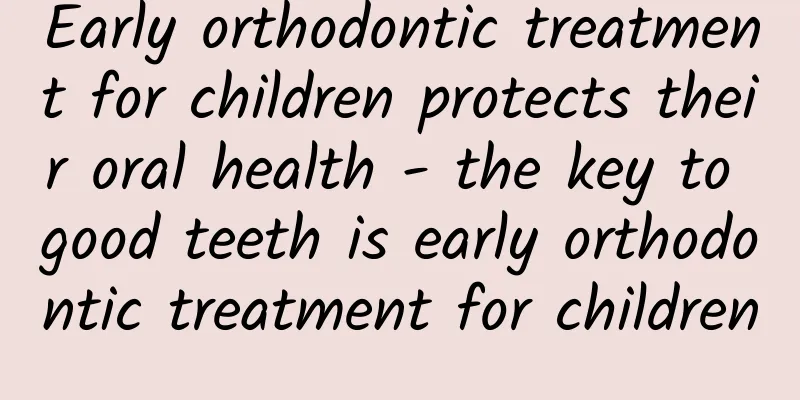Early orthodontic treatment for children protects their oral health - the key to good teeth is early orthodontic treatment for children

|
Author: Ahesha Wulie, School of Stomatology, Huazhong University of Science and Technology, Postgraduate Science Popularization Team of Huazhong University School of Stomatology Instructor: Yang Shengli Wuhan Union Hospital Introduction: Children's dental health is related to their growth, development and self-confidence, and early correction is an important means to ensure children's oral health. This article will provide you with relevant knowledge about early correction of children's teeth, helping you to create neat and healthy teeth for your children. What is early correction? Early correction refers to the treatment of malocclusion, deformity trends and possible causes of malocclusion in the early stages of a child's growth and development (between 3.5 and 12 years old, when the dentition is in the period of deciduous dentition and replacement dentition), blocking and treating abnormal growth and development, thereby guiding the normal growth of the teeth, dentition and maxillofacial region. Orthodontics usually refers to orthodontic treatment of malocclusion of teeth and jaws during the permanent dentition period, usually after the age of 12 and in adulthood. Why early correction? Some parents think that their children's deciduous teeth will fall out sooner or later, and early treatment is a waste of time and money. In fact, early treatment has three main meanings: prevention, blocking and treatment. Prevent and block the occurrence of malocclusion in children: It can effectively reduce the incidence of malocclusion in children. Good for oral health: Early correction can help children correct problems such as uneven teeth and poor occlusion, and reduce the risk of oral diseases such as tooth wear, tooth caries, and periodontal disease. Promote growth and development: A good occlusion relationship is beneficial to the child's chewing function, helps digestion and absorption, and promotes growth and development. Improve appearance: Neat teeth can make children have a confident smile, which is beneficial to facial beauty and mental health. Reduce the difficulty of secondary correction: simplify its complexity, reduce the proportion of clinical tooth extraction, and reduce the proportion of craniofacial deformity surgery. Children's teeth need correction Anterior crossbite (underbite): When the lower teeth are in central occlusion, the lower teeth cover the upper teeth, which not only affects the occlusal function but also may lead to restricted development of the maxillary bone. Retruded mandible (small chin): refers to underdeveloped chin. Severe dental crowding during the period of tooth replacement: The teeth are crowded, misaligned and unevenly arranged, mainly because the number of teeth is greater than the bone volume, resulting in abnormal tooth shape. Crowded teeth are manifested in the mouth as normal or too wide teeth, and the teeth are misaligned in various directions. Premature loss/retention of deciduous teeth: If a child’s deciduous teeth fall out prematurely/fail to fall out on time, it may cause other teeth to shift and affect the normal eruption of permanent teeth. Poor occlusion: such as the front teeth biting too deeply (deep overbite), the front teeth being unable to bite together (open bite), the back teeth locking together, etc. Bad oral habits: such as long-term sucking of fingers, biting of lips, sticking out of tongue, etc., may lead to misaligned teeth or abnormal jaw development. Respiratory problems: Mouth breathing during sleep due to rhinitis, enlarged tonsils, or adenoids may affect the normal development of the face and teeth. Genetic factors: If a parent has crooked teeth or bite problems, their child may also have similar problems. Crowded dentition, sparse teeth, open bite, deep overbite, crossbite, buck teeth The best time for early orthodontic treatment of children Early orthodontic treatment for children is divided into two stages: The deciduous teeth period (3-5 years old): At this time, the deciduous teeth in the child’s mouth are basically replaced, which is the best time to correct malocclusion of deciduous teeth. Tooth replacement period (6-12 years old): During this period, the permanent teeth in the child's mouth gradually replace the deciduous teeth. This is a critical period for correcting permanent tooth malocclusion. Correction during this period can fully utilize the growth and development potential of the child's teeth and jaws to achieve better correction results. 5. Methods of early correction of children's teeth Removable braces: They can be put on and taken off by yourself, and are easy to clean. They are suitable for simple malocclusion problems. You can choose the appropriate braces according to the child’s age and dental condition. Fixed orthodontic appliances: Suitable for more complex dental malocclusion problems, such as crowded teeth, malocclusion, etc. Fixed orthodontic appliances apply force to the teeth through brackets and archwires attached to the teeth, so that they gradually move to the correct position. Functional orthodontic appliances: suitable for children in the growth and development period, they promote the normal development of teeth and jaws by adjusting the function of oral muscles. Invisible braces: suitable for mild to moderate malocclusion problems, with the advantages of beauty, comfort and convenience. 6. Precautions for early orthodontic treatment of children Choose a regular medical institution: For early dental treatment for children, you should choose a regular medical institution to ensure that the treatment is safe and effective. Regular review: Regular review is required during the treatment process to adjust the treatment plan in a timely manner. Children and parents should be fully prepared and should not rush for success or give up halfway. Maintain oral hygiene: During the correction period, children need to maintain good oral hygiene habits to avoid the accumulation of food debris and reduce the risk of oral diseases. Active cooperation: Parents need to encourage their children to actively cooperate with doctors in treatment, go for follow-up visits on time, and ensure the effectiveness of correction. Parents don’t want their children to lose out in terms of appearance. The growth and development of dentition, occlusion and maxillofacial area in childhood is the most active stage. Early correction can achieve twice the result with half the effort by taking advantage of the situation and combining the growth potential of children! Parents should pay attention to the development of their children’s teeth, grasp the timing of correction, and choose the appropriate correction method to protect their children’s oral health and facial beauty! |
<<: "From bright smiles to frozen expressions, these little daily actions are the culprits!"
>>: The secret files of oral cancer: How to outsmart this “invisible killer”?
Recommend
Are false labors normal during pregnancy?
Uterine contractions in late pregnancy mean that ...
What are the dangers of scoliosis in women?
How does scoliosis affect women? Is it dangerous?...
Signs of second childbirth 10 days before delivery
China has now opened up its two-child policy. Not...
Women often drink four kinds of health-preserving tea to replenish qi and nourish blood!
Women's qi and blood are directly related to ...
What are the advantages of Shiranui? How to distinguish the real and fake Shiranui
The scientific name of the "ugly orange"...
A must-read for women! How terrible is “corpus luteum rupture”?
The following incident happened at the Asian Game...
Breast care measures after weaning, these methods can help you
The process of breastfeeding can cause great harm...
Why does dysmenorrhea cause vomiting?
Some people will have more severe dysmenorrhea, s...
Mr. Xin and Mr. Ling's "Healthy Meta-Universe"
This is the 3538th article of Da Yi Xiao Hu Mr. X...
Can I have foot massage while breastfeeding?
Foot massage has a history of about 4,000 years i...
Why do we spread wood ash when planting? How to apply wood ash when planting ginger?
Wood ash is the ash left after burning firewood. ...
Horrible! This smell is actually an "invisible killer" in the home, endangering the health of the whole family...especially the children
According to the "China Smoking Health Repor...
How to take care of the waist pain of pregnant women
Having a baby can be said to be a big event in ou...
The amount of menstrual flow after abortion is frighteningly small
If the menstrual flow is very light after abortio...









